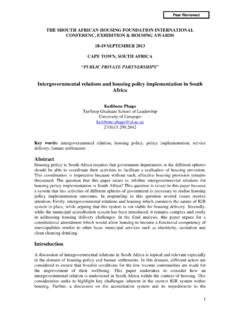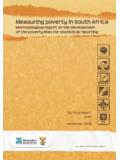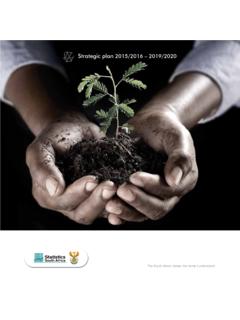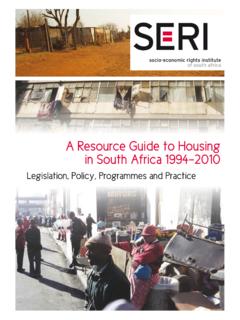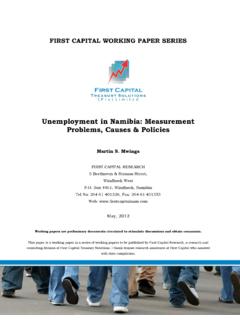Transcription of Housing Subsidy Criteria and the Housing Backlog …
1 Peer Reviewed Subsidy Criteria and the Housing Backlog in south africa THE SOUTHERN AFRICAN Housing FOUNDATION. INTERNATIONAL CONFERENCE, EXHIBITION. & Housing AWARDS. 18-19 SEPTEMBER 2013. CAPE TOWN, south africa . PUBLIC PRIVATE PARTNERSHIPS . Housing Subsidy Criteria and the Housing Backlog in south africa Judith T Ojo-Aromokudu School of Built Environment and Development Studies University of Kwazulu Natal +27 31 260 2427. Keywords: Housing Subsidy , Housing Backlog , target efficiency, relative poverty, Household cycle, Military veteran Housing Backlog , Abstract: max. 300 words Housing Backlog in south African Housing rhetoric, which refers to the persistent shortfall in Housing delivery, seems to have come to stay despite various government interventions to overcome its occurrence.
2 As a targeting tool the Subsidy Criteria is falling ahort in reaching the intended poorest f the poor as spelt out in the Housing White Paper. The initial Reconstruction and Development Program (RDP) of 1994, the Breaking New Ground (BNG) initiative of 2003, have The paper argues that the current Housing Subsidy Criteria is falling to efficiently reach the poorest of the poor and more alarmingly creating an exponential growth in the Housing Backlog . The paper starts out by review the intention of south African Housing Policy. It then outlines a theoretical framework based on Beckerman's targeting scheme, household life cycle, and structure. Within this framework the Housing Subsidy selection Criteria is discussed, and argues that the selection Criteria , while careful not to subsidies individuals more than once, has loop holes which allows for beneficiaries' to become primary applicants over time.
3 An empirical survey is carried out in the Umhlathuze Village North of Kwazulu Natal using the questionnaire, interviews with municipal Housing officials. The paper concludes by calling for a review of the selection Criteria by clearly defining target group, and developmental vision for the state funded human settlements. Author: Judith T. Ojo-Aromokudu 1. Subsidy Criteria and the Housing Backlog in south africa Introduction The right of every south African to access adequate Housing is enshrined in section 26 of the south African Constitution. Meeting this target has been one of the obligations of the state, especially in post apartheid years (Wilkinson 1998). The initial Reconstruction and Development Program (RDP) of the first democratically elected government in 1994 took on the task and made huge strides investing billion in state assisted Housing and delivering million Housing opportunities in the first ten years in office' (DoH 1994).
4 The concern was not only to address what officially is termed as inadequate shelter in form of squatter settlements and hostel accommodation (Wilkinson 1998), but also to reduce the Housing Backlog ' reported as urban informal units in 1994 (DoH 1995). The DoH reported that delivery of urban informal Housing units reached a level in excess of 120,000. units per annum over the three year period prior to 1995. The debates have since shifted from the quantity to quality in the last decade when the Breaking New Ground (BNG) policy was put in place in 2004. The BNG pinpointed some unintended outcomes of the Housing policy which included the increasing Housing Backlog ; slowdown in delivery; poor quality products; lack of community participation; corruption and maladministration; and the continued growth of informal settlements (Tissington 2011).
5 The BNG policy was however met with critics from some sectors, and soon after in 2009 the Department of Housing was reshaped and took on the name Human Settlements. All these efforts by the government were aimed meeting the mandate of the constitution ie the right to access adequate Housing for all. However the Housing Backlog persists and it is estimated that by 2016 an amount of R253 billion will be needed to clear the Housing Backlog (DoH 2007). The DHS reports that the Backlog has grown exponentially since 1994, and continues to grow due in part to household structure, rapid urbanization, migration to the cities and large towns, lack of opportunities in rural areas, structural unemployment, more households falling into the Subsidy income band and less access to Housing finance (DHS 2009).
6 This prompted the then Human Settlement Minister Tokyo Sexwale to express concerns that it is not the states intention to create a beggars culture .but the states effort are just a safety net for the poorest of the poor, but cannot go on forever' (Tokyo Sexwale 2009). This position paper argues that continuing with the current Housing Subsidy qualification Criteria is leading to the exponential growth of the demand for state funded Housing and a review of the Housing Subsidy qualification Criteria in south africa is long over due. The efficiency of the qualification Criteria is therefore question in real terms as to where it is reaching the targeted poorest of the poor as spelt out in the policy document.
7 A target efficiency analysis model is discussed alongside the definition of poverty, household characteristics and household cycle models. In order to understand the impact of the Subsidy Criteria on the Housing Backlog , a field survey is conducted using interview and focus group discussions with residents of the Umhlathuzi Housing village in Northern Kwazulu Natal. Respondents were asked how they were able to access their dwelling unit. This settlement was chosen as it was one of the Housing settlements rolled out in 1996 post aparthied. Interviews were also conducted with Housing practitioners in the local municipality. the research reviews the Housing Subsidy Criteria and discusses the Subsidy qualification Criteria , outlining various impacts on the number of households that are eligible for state Housing assistance.
8 A literature review of past Housing policy and strategic policy objectives is undertaken alongside other Housing documents. south African Housing Policy Internationally, the purpose of Housing Policy is to allow the largest number of families, or ideally every family to obtain a suitable dwelling in terms of location, quality dimension and price (Iommi 2009). It acknowledges the importance of Housing as a primary asset, in terms of their qualitative characteristics (location, dimension, state of preservation, facilities, equipment, etc.) and economic burden have strong repercussions on the quality of life and household budgets (ibid). Housing policy statements in line with the UNMG recognizes the right of all to access adequate Housing in individual country context.
9 While this is the case in south africa Housing policy has also been used as a political tool. Author: Judith T. Ojo-Aromokudu 2. Subsidy Criteria and the Housing Backlog in south africa Historically Housing policy in apartheid south africa was used as a systematic tool of control and racial segregation. Efforts in state Housing were reported to be in response to plague spots' and half hearted' initiatives at Housing the targeted group ie the segregated African group (Wilkinson 1998). Post 1994 Housing policy has been used as a political tool to win votes by targeting much the same segregated African group who now constitute the poorest of the poor. So while the right to access to Housing is of concern, the approach was a continuation of the Housing policy of the apartheid era and focus was on clearing the over million urban Housing Backlog created by the apartheid government.
10 With little (or no) redefinition and appraisal of the Housing problem towards a strategic approach, the same Housing typology and settlement patterns of the apartheid era have been carried through to the post apartheid era (Frescura & Riordan 1986). The use of Housing delivery as a political tool was evident at the onset of democracy when focus was on quantity of units delivered with little regards for qualitative characteristics as described above. Target efficiency Measurement The target efficiency scheme developed by Beckerman in 1979 is a means of measuring efficiency of targeting with regards to allocation of income allowances to fight. Iommi (2009) explains how this model measures the impact of assistance on the levels of poverty, thereby indicating if the assistance either from (private or public sector) shifted poverty levels from a relative point to a predetermined acceptable point.
